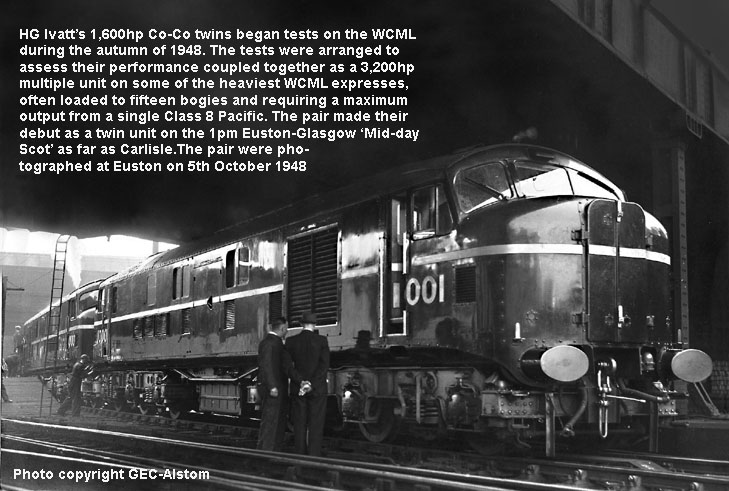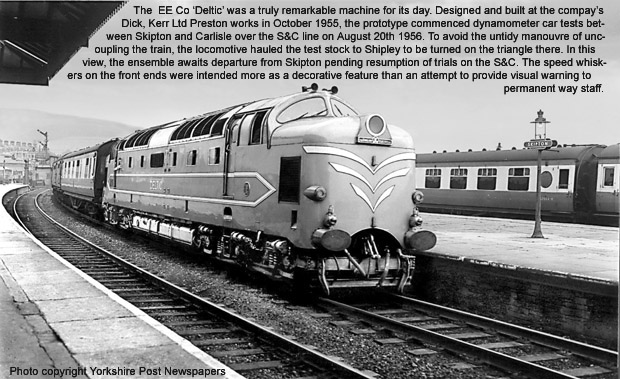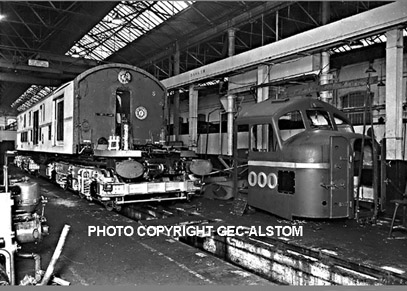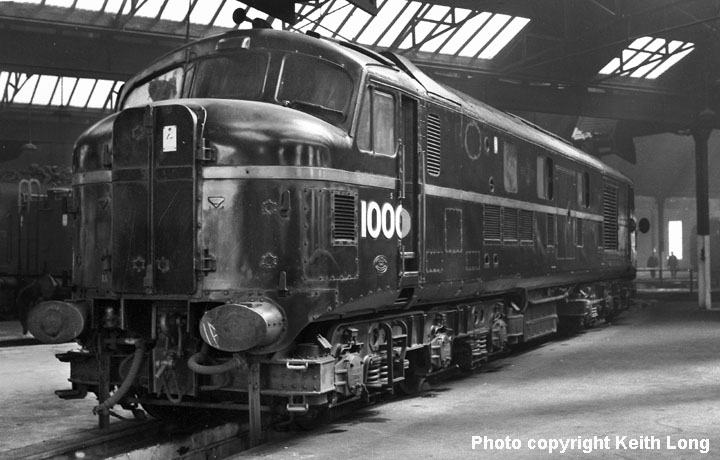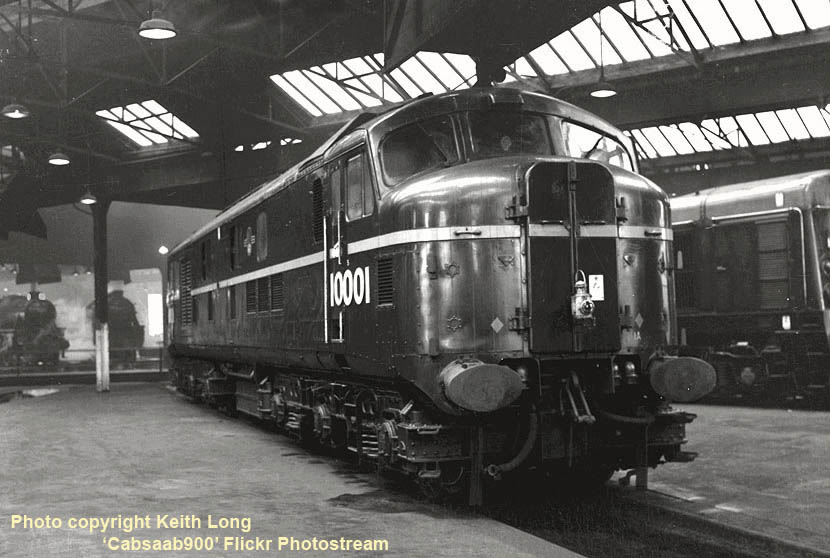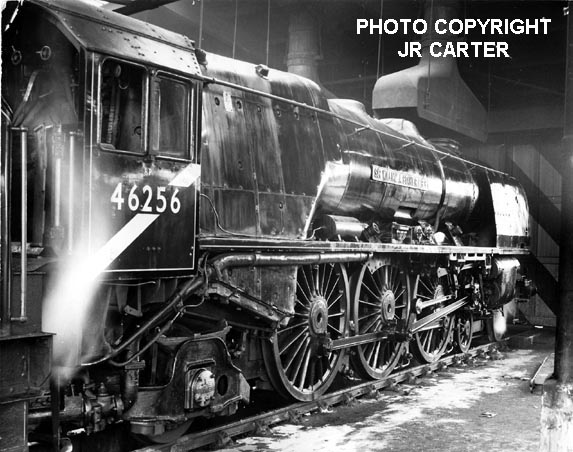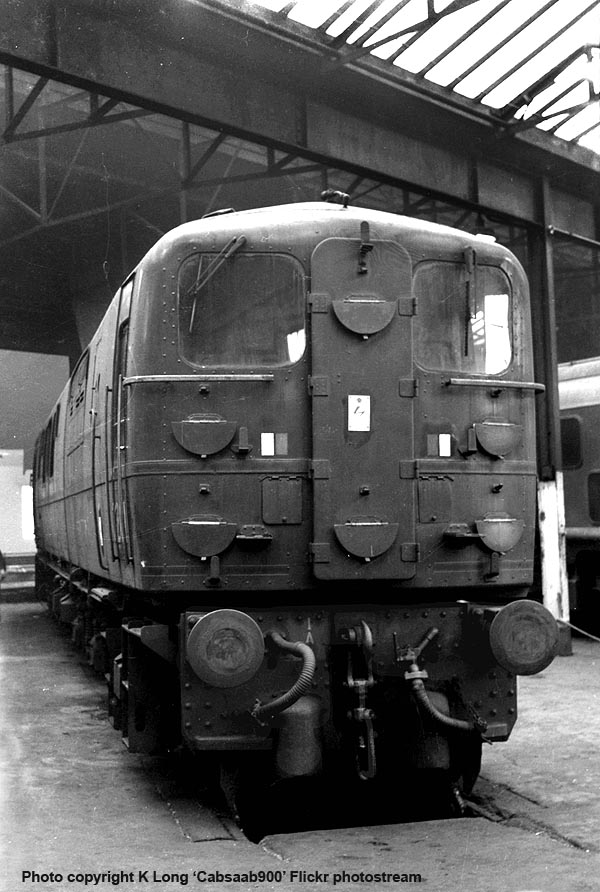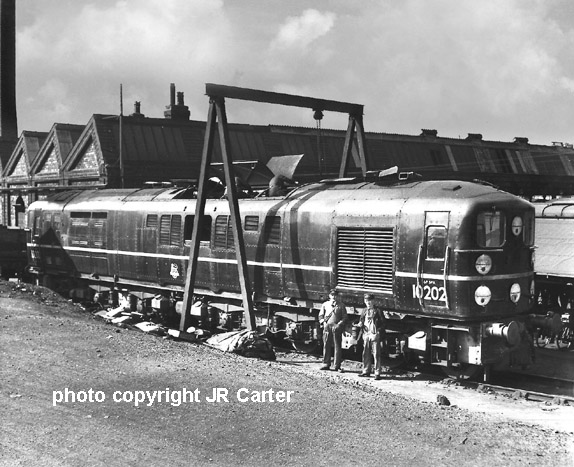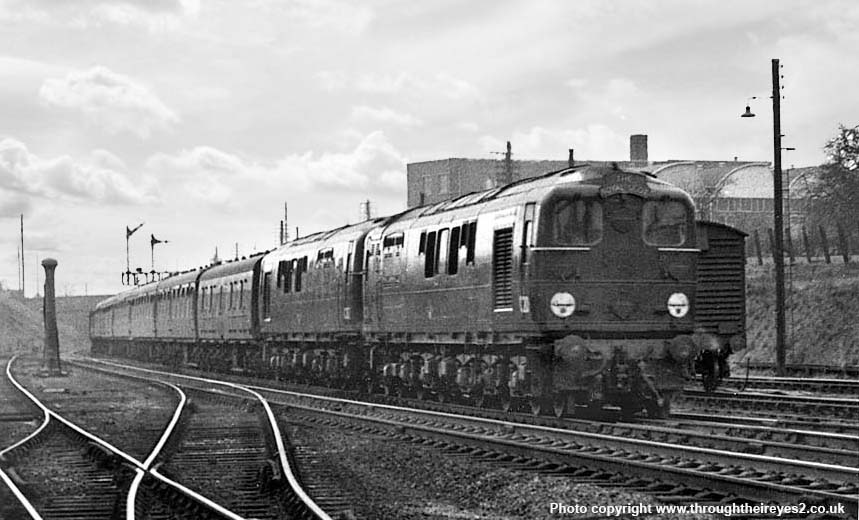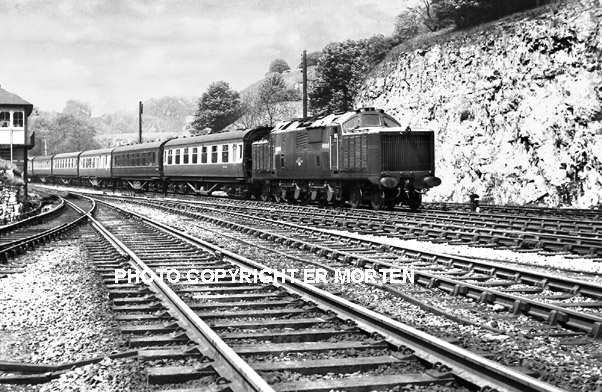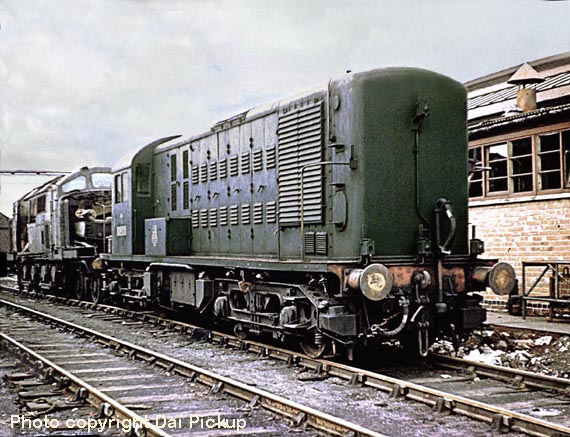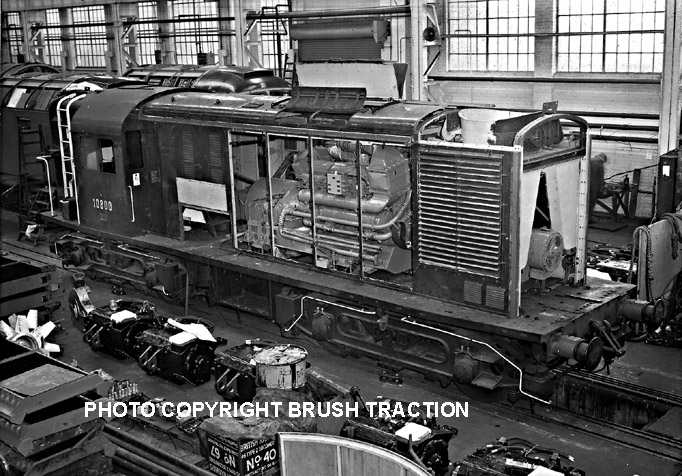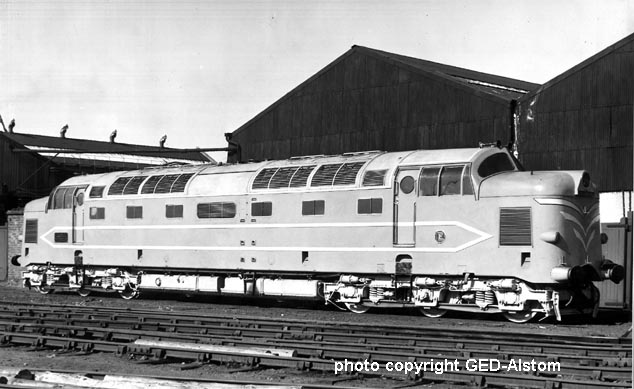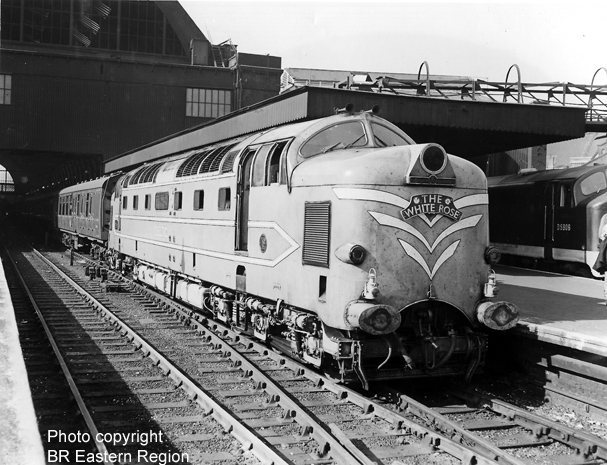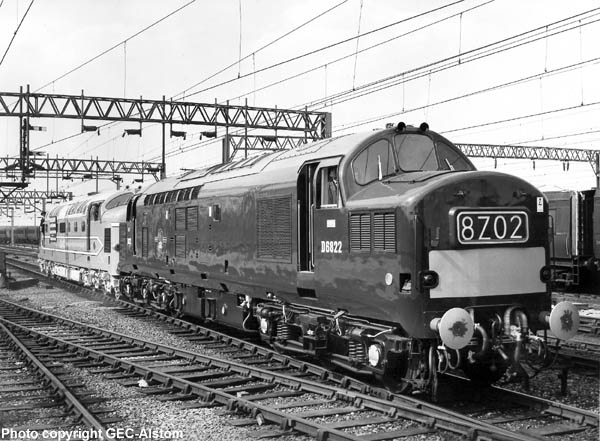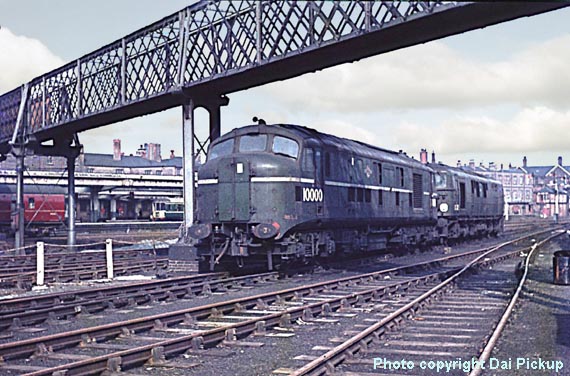Few of us who grew up in the halcyon days of steam could have forseen its astonishingly swift decline. It began on January 25th 1955 at the announcement of the £1,240 million Modernisation Plan which spelled out the British Transport Commission's (BTC's) scheme for large scale modernisation of the rail network, the principle feature being the ultimate replacement of steam by diesel and electric traction. 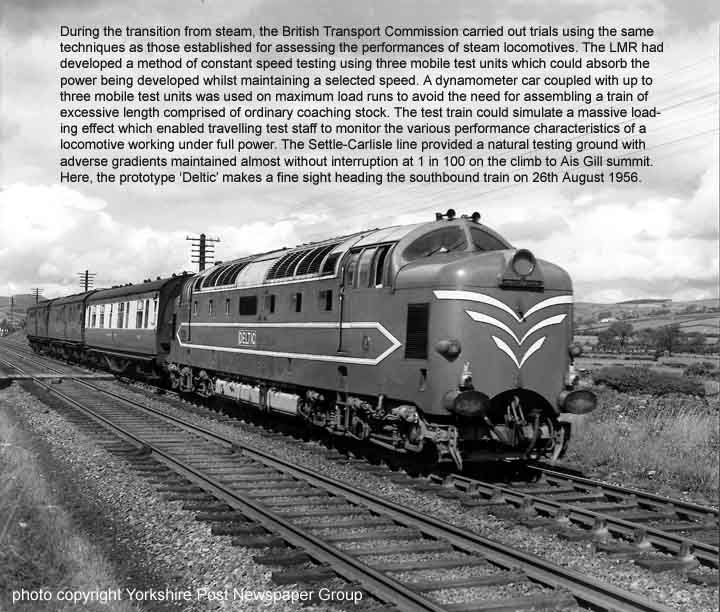 When the BTC's plan was announced, diesels were still something of a novelty. The LMSR built the first in 1947, though many would argue that WG Armstrong Whitworth & Co of Tyneside beat them to that distinction, since the company had already built an 880hp 2-C-2 in 1933 which was tested on some LNER routes in the north-east of England.
When the BTC's plan was announced, diesels were still something of a novelty. The LMSR built the first in 1947, though many would argue that WG Armstrong Whitworth & Co of Tyneside beat them to that distinction, since the company had already built an 880hp 2-C-2 in 1933 which was tested on some LNER routes in the north-east of England.
However, as the 2-C-2 locomotive always remained the property of the company, the actual British protype for main line diesel - exemplifying the true metamorphosis from steam to diesel power - was the pioneer LMS Co-Co, No 10000. The locomotive was designed by HG Ivatt in collaboration with the English Electric Co, and unveiled at a ceremony at Euston station on December 18th 1947. It was joined by a second Co-Co, No 10001, a few months after nationalisation.
Back in 1955 I was a small boy in short pants who stubbornley refused to believe that BR steam would end within fifteen years. In those days, brand new steam power was still rolling off the production line in the shape of the BR Standard class locomotives, and so the absurd notion that steam would be scrapped (in some cases after a working life of just four years) just beggared belief.
For as long as I could remember, steam had played an important part in my life, which probably accounts for the resentful opinions I then had of diesels. In my view they were ugly, square boxes on wheels, devoid of any character whatsoever.
Yet more than fifty years on, time has since tempered my judgment, for the demise of steam, regrettable though it was, gave spotters the chance to enjoy, arguably, one of the most interesting episodes in railway history...the transition from steam.
The other five main line diesel locomotives working on BR in the mid-Fifties included No 10800, a North British-built Paxman/BTH 827hp Bo-Bo diesel electric originated by the LMS, but not delivered until 1950. This was followed by another LMS idea in the unusual shape of the Fell diesel-mechanical 2Bo-Bo2 No 10100 which appeared in 1951. The English Electric Company was also involved in the Southern Railway's 1,750hp ICo-Co1 twins Nos 10201/2 in 1951, both locomotives being the forerunners of the more powerful, No 10203, a 2,000hp 1Co-Co1 built at Ashford Works in 1954. The Southern Railway also built the Bullied/Raworth electric locomotives Nos 20001-3 between 1941-48, and the GWR carried out traction experiments with the Gas Turbine A1A-A1A locomotive No 18000, purchased from Brown Boveri of Switzerland, followed by No 18100, built by Metropolitan-Vickers.
But the daddy of them all - the English Electric Co's 3,300hp Deltic appeared in traffic during October 1955. Unofficially designated DP1 - 'Diesel Prototype One' - the English Electric Co 3,300hp Co-Co diesel prototype was sponsored by the company in order to assess their marine Napier-Deltic engine in rail use. The widespread use of alloy in its construction led to a comparatively lightweight high rpm diesel engine which could be mounted on a Co-Co wheelbase. The prototype was intended to be called Enterprise, but the name was dropped when it was found that Hudswell Clarke of Leeds had a range of locomotives bearing the same name. As a result, the EE Co prototype became known as Deltic, derived from the 'V' shape of the engine resembling that of the inverted Greek letter 'Delta'. See Class 55 Page 17.
(Above) The English Electric Co's 3,300hp 'Deltic' Co-Co heads south out of York on a test run - just visible are cables trailing from the window of the rear cab to the LNER's Dynamometer Car No DB99950, the leading coach in the ensemble. The burley proportions of this prototype seemed to stretch the loading gauge to the limit. During a proving run to Berwick it dislodged chunks of platform-edge coping at Manors Station, Newcastle - and a close encounter with a platform at Darlington cost a new set of cabside steps. As a result, the prototype was employed mainly on the ECML south of Leeds, and photos of 'Deltic' at York are rare. In view of the clearance problems, the production fleet of 22 locomotives appeared with a revised bodyside contour swept in at the waist to comply with the rigid restrictions of the British loading gauge - no more than 9ft wide over the body and 7ft 6ins below the underframes. The difference can be seen on the Deltic page mentioned above.
THE GENESIS OF MAIN LINE DIESELS
Prior to nationalisation, the LMS had built up a fleet of sturdy six-coupled diesel shunters, constructed to designs conceived during the 1930s, several of which survived into BR days. In 1947, the country was still in the grip of post-war stringencies, so when the LMS decided to develop Britain's first 'main line' diesel locomotive it was adjudged unwise by critics on account of the huge expenditure involved. Undeterred, the Derby team forged ahead, taking less than eight months to progress from the drawing board to construction. Designed by HG Ivatt in collaboration with the English Electric Co, who at the time was the main contender for the British diesel engine business (the company supplied the 16SVT Mk 1 engine, generator and traction motors) the first of the Co-Co twin No 10000 made its debut in December 1947, just a few weeks before nationalisation. As it turned out, No 10000 was a thinly-disguised copy of 1940s-style USA diesels, but the Derby team was not allowed the rather generous loading gauge to be found on American railroads - 1ft extra in height and width, and a permissible axle load of 28 tons. With just over 21 ton axle load, the pioneer British main line diesel 1,600hp Co-Co was a remarkable design for 1947. Photo © GEC/Alstom
(Above-Below) Two great shots from Keith Long's 'Cabsaab900' Fickr photostream. One of the great things about opening a Flickr account is that visitors are given the chance to comment on your photos. For example, this excellent interior shot (above) at Willesden depot of HG Ivatt's Co-Co No 10000 on 2nd July 1961 created some dialogue. It goes to prove that there must be countless thousands of enthusiasts who were disappointed that such an important locomotive was not saved from the cutters torch. Indeed Keith has posted his own comments - 'The real shame is that the loco survived so long after being withdrawn in December 1963 (it was not cut up until January 1968). It would have been better to have saved something like this rather than say eleven out of the thirty 'Merchant Navy' class. It's not that I have anything against the MNs, or steam in general; it's just that the preservation scene is so unbalanced. Still I remember watching 10000 & 10001 at Watford Junction heading the 'Royal Scot' express during the 50s and 60s, and a lot of people didn't have chance of that.' (Below) The second of the pair, No 10001 is seen at Willesden on 19th May 1962. Click on this link to visit Keith's main collections of railway photos. The collection continues to grow and contains a massive number of sets. Cabsaab 900 photostream'
(Above) Whilst Derby Works was involved in the construction of the pioneer British main line diesel locomotives, the LMS was completing the last pair of Stanier's 'Coronation' class Pacifics Nos 6256/57 at Crewe works. At the time, the LMS was primarily concerned in improving the design and efficiency of its existing steam classes by incorporating some of the best features the company had developed. The involvement of HG Ivatt (then Chief Mechanical Engineer of the LMS) in the last two Stanier Pacifics resulted in both engines being fitted with self-cleaning smokeboxes, full rocking grates, modified hopper ash pans (necessitating re vised trailing trucks and shallower cab side plates) in addition to which roller bearings were fitted to all axles. No 6256 entered traffic in December 1947 and No 6257 after nationalisation in May 1948 - both locomotives representing the highest development of British steam design. On September 25th 1964, railwayman Jim Carter was at Crewe North shed to photograph the last working Stanier Pacific No 46256 Sir William Stanier, FRS on the eve of the return farewell special from Crewe to Carlisle. It is hard to imagine that in less than 48 hours this immaculate engine would be consigned to the scrap heap. For the record, the pioneer main line diesel, No 10000, met the same fate in December 1963, a year earlier. Photo © JR Carter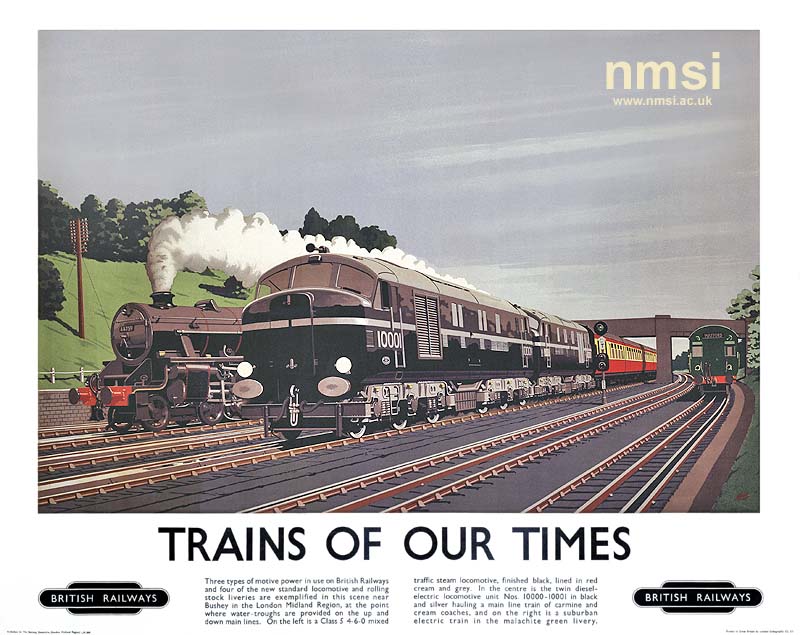
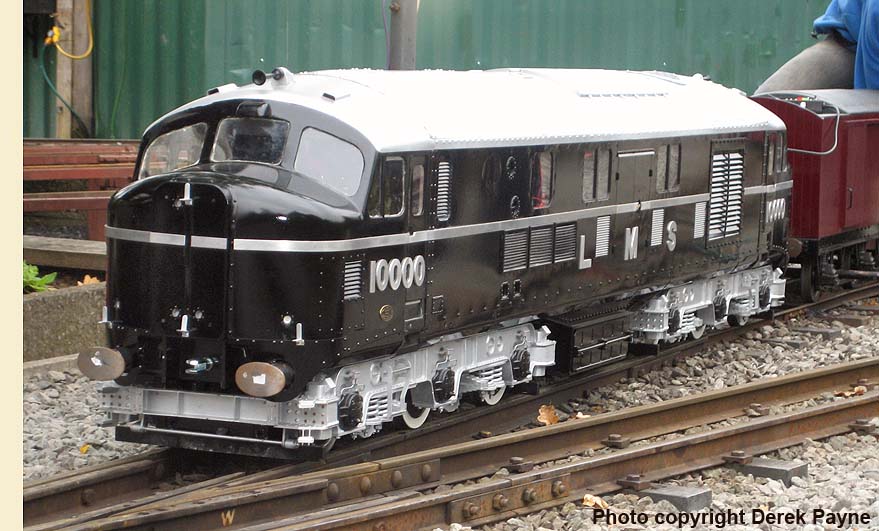 (Inset Right) Derek Payne writes - 'I have just visited your website looking for pictures of LMS 10000 and 10001 diesels. There are some excellent photographs of the Ivatt twins and other types of early British diesel pioneers. I have made a model of No 10000 in 7¼" gauge (one-eighth full size approx) and am now working on 10001. The pair will be around 5 metres long when coupled together. This will probably be about as near as one shall ever get to seeing the twins again; the pair were scrapped in one of the worst decisions ever made by the National Museum and British Railways acting with a complete lack of foresight. I have attached a picture of the model of 10000 which still requires details to be completed such as vents, guard irons and buffer shrouds. I do so hope that you find this of interest...' Click on photo to enlarger
(Inset Right) Derek Payne writes - 'I have just visited your website looking for pictures of LMS 10000 and 10001 diesels. There are some excellent photographs of the Ivatt twins and other types of early British diesel pioneers. I have made a model of No 10000 in 7¼" gauge (one-eighth full size approx) and am now working on 10001. The pair will be around 5 metres long when coupled together. This will probably be about as near as one shall ever get to seeing the twins again; the pair were scrapped in one of the worst decisions ever made by the National Museum and British Railways acting with a complete lack of foresight. I have attached a picture of the model of 10000 which still requires details to be completed such as vents, guard irons and buffer shrouds. I do so hope that you find this of interest...' Click on photo to enlarger
Since Derek contacted this site he fears that he may now have to eat his words, for a group has just been formed with the intention of recreating a full-sized working LMS 10000. The new group is the 'Ivatt Diesel Recreation Society' and already an extraordinary amount of information and drawings of 10000 have been found, plus a number of main components. It is early days yet, but as an engineer, the prospect for Derek Payne is most exciting - as it is for all diesel fans. Click on link. http://www.lms10000.org
(Below) Peter Siddall is also building a version of HG Ivatt's Co-Co No 10000 in 5" gauge. He has met Derek Payne and admired his 7¼" gauge locomotive at the Fosse Exhibition. Peter writes - 'The model is almost finished but the paintwork has proved to be a disaster. I used aerosols from a well known retailer of household goods only to find that they didn't cure properly, marked far too easily and reacted badly to clear lacquer. It looks okay from a distance but after all the work involved in constructing the loco it comes as a severe disappointment. Don't they test this stuff before it is put on the shelves? My only alternative is to strip it all off and start again which means buying more lettering which did not come cheap. The loco will be at the Fosse Exhibition in October 2011 on the Erewash club stand but I will put it on the back shelf out of the way...hair and tearing are the words that spring to mind!'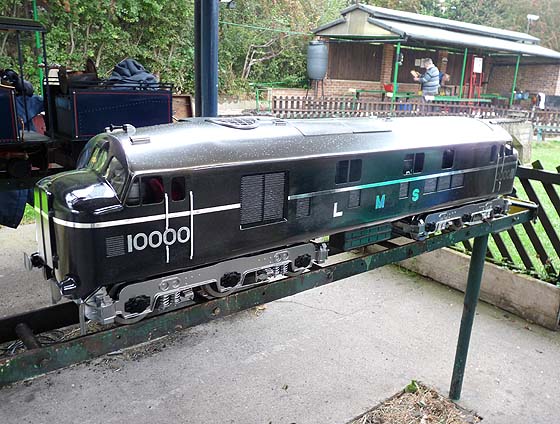
(Below) The official handing-over ceremony of No 10000 occurred at Euston on December 18th 1947 at which Sir George Nelson, Chairman and Managing Director of the English Eelectric Co, and Sir Robert Burrows, Chairman of the LMS, spoke of 'the importance of the experiment'. Understatement indeed! The timing of the hand-over (just prior to nationalisation) was chosen with some deliberation as the LMS was keen to see their new diesel locomotive - being entirely LMS in origin - should bear the company's insignia in traffic. The black and silver livery eventually gave way to BR Brunswick green in 1956. The former CME of the LMS, Sir William Stanier, was also at the handing-over ceremony, to attend the unveiling of the nameplates on No 46256 (see below) Photo © GEC/Alstom

(Above-Below) Prior to nationalisation, the Southern Railway was the most progressive of all the four main railway companies having invested heavily in 3rd rail electrification during the 1930s.
The SR's Chief Mechanical Engineer, OV Bulleid, had plenty of experience with small-wheel multiple unit motor bogies, but was looking at diesel-electric traction as an alternative to costly third-rail electrification on some west of England routes. The result was the SR/EE Co diesel electric No 10201, built at Ashford works in 1950. The power unit was the same 16-cylinder 16SVT engine as fitted to the LMS Co-Cos, but equipped with the EE Co's Napier 75100 Turbocharger producing a 1,750hp prototype.
Excellent front end detail can be found in these great shots of the SR's No 10201 (sporting BR's Brunswick Green livery) at Willesden shed on 2nd July 1962 (above) and inside the Willesden roundhouse (below) on 19th May 1962. Photos © Keith Long. Check out Keith's 'Rail Cameraman' Page 47 - the page provides a link to his BR Flickr 'BR Diesels' photostream.

(Above) The first of the SR's main line diesels, No 10201 was photographed at Crewe in July 1962 by Dai Pickup. Unlike the contemporary American nose of the earlier LMS diesels, the SR locomotives had flat ends with rounded corners, giving them a rather distinctive box-like appearance. However, the subtle body-side contours followed that of traditional Bulleid coaching stock, which was a nice design touch.
(Below) Because of the bulky medium-speed engines and electronic plant then available, the SR trio had to be mounted on 1Co-Co1 bogies - made up of three motored wheel sets and an outer non-powered guiding axle to distribute the weight. The longer wheelbase was designed by OV Bulleid to meet the requirments of the SR's Chief Civil engineer, who wanted to spread the axle load and reduce excessive rail wear. When the new pilot scheme diesel locomotives were ordered by the BTC in 1955, BR's Civil Engineers shared the same anxieties. As a result, strict stipulations were put in place to limit wheel diameter in relation to axleload which led to the cumbersome 1Co-Co1 bogies being inflicted on the EE Co Type 4 D200s and the BR/Sulzer 'Peak' class - to the detriment of some 10 to 20 tons extra deadweight. In 1955 the SR/Bulleid trio were appropriated by the LMR for evaluation against the earlier Co-Cos Nos 10000/1, but the performance of the prototype diesels were impaired by the dire conditions under which they were kept. This view of Crewe South shed shows the second of the trio No 10202 (in original black livery) receiving attention at 5B in 1955. Photos © Dai Pickup/JR Carter
 The BR power classification code above the number of 10202 - '6P5FA' - was adopted from the old LMS system using the numbers 0-9 to indicate power, based on tractive effort calculations, and the letters 'P' for passenger and 'F' for freight to indicate the type of work the locomotive was designed. The code used on the SR's Nos 10201/2 was just short of the '7P5F' classification of the SR Bulleid light Pacifics. This identification system was used on the LMR and Southern Region only, whereas the Western Region continued to use the old GWR classification code, with the power rating based on letters A-E and coloured dots for route availability. On some Eastern Region locomotives, the route availability code (RA1 to 9) was preferred, while the designation 'MT' for mixed traffic was added to the new standard designs with the exception of the BR Class 9F 2-10-0s and the now preserved No 71000 Duke of Gloucester which still carries the '8P' code above its cab side number.
The BR power classification code above the number of 10202 - '6P5FA' - was adopted from the old LMS system using the numbers 0-9 to indicate power, based on tractive effort calculations, and the letters 'P' for passenger and 'F' for freight to indicate the type of work the locomotive was designed. The code used on the SR's Nos 10201/2 was just short of the '7P5F' classification of the SR Bulleid light Pacifics. This identification system was used on the LMR and Southern Region only, whereas the Western Region continued to use the old GWR classification code, with the power rating based on letters A-E and coloured dots for route availability. On some Eastern Region locomotives, the route availability code (RA1 to 9) was preferred, while the designation 'MT' for mixed traffic was added to the new standard designs with the exception of the BR Class 9F 2-10-0s and the now preserved No 71000 Duke of Gloucester which still carries the '8P' code above its cab side number.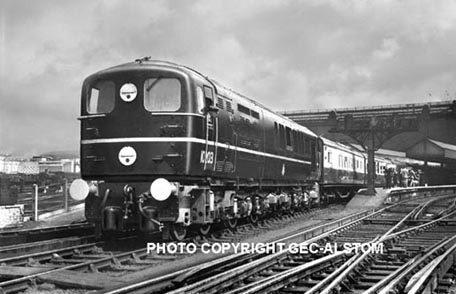
(Above-Below) Whilst the SR/English Electric 1,750hp ICo-Co1, No 10201, emerged from Ashford Works in November 1950, followed by 10202 in August 1951, the third of the trio, No 10203, didn't enter traffic until April 1954. The loco resembled the earlier pair (with output raised to 2,000hp) and joined sister engines 10201/2 at Camden after being appropriated by the LMR for use on a variety of duties - Anglo-Scottish, Birmingham and Manchester, with frequent spells on locals to Bletchly. The additional horsepower of No 10203 gave it a distinctly superior performance, often working the 'Royal Scot' single-handed. By 1962, No 10202 had completed 750,000 miles; 10202 (600,000 miles) and 10203 (480,000 miles) but at the end of 1963 the three SR diesel-electrics were withdrawn. Here, No 10203 awaits departure from Waterloo with a west of England express. (Below) A sign of things to come: Tamworth on 12th February 1957 and the northbound 'Royal Scot' is in the hands of the SR/EE Co diesel electrics No 10201-2 in place of the usual Stanier Class 8P Pacific...the times they were a changing.
(Above) Although committed to replacing steam with diesel and electric power, the British Transport Commission continued to show a keen interest in developing any type of motive power which showed promise of economies in rail operation, including the conversion of a number of steam locos to oil firing. Meanwhile, the GWR had begun experiments in conjunction with the Swiss firm of Brown Boveri to build a gas-turbine electric locomotive capable of producing the equivalent power of a 'King' class locomotive. The Brown Boveri A1A-A1A gas-turbine No 18000 was followed by a new British design, No 18100, mounted on Co-Co bogies with each axle of its two 6-wheeled bogies independently motored. The Government was also interested in comparing the thermal efficiency and potential economies in fuel costs of a 'coal-fired' gas turbine against existing steam power, therefore the Ministry of Fuel and Power placed an order with the NBL Co's Glasgow works for a new A1A-A1A locomotive. Experts believed that a coal-fired gas turbine locomotive could work the London-Glasgow run using half the coal consumption of a Stanier Pacific. In fact, the GWR gas turbines did demonstrate their ability to produce a power well beyond any steam locomotive then operating on the Western Region, but the BTC took the decision to abandon all forms of main line traction other than steam and the interesting gas-turbine experiment came to an end. The new British locomotive No 18100 is seen at the Metropolitan-Vickers works on Teesside.
(Above-Below) In 1950, an altogether unusual-looking diesel-mechanical locomotive appeared from Derby works in the shape of the Fell 2Bo-Bo2 No 10100. The locomotive was powered by four Paxman 12-cylinder engines arranged in pairs beneath each bonnet, which gave a locomotive power of 2,000hp. No 10100 had a novel mechanical transmission consisting of a differential drive and fluid couplings connected through one central gearbox to its four driving axles. However, the success of any diesel traction depends on a favourable power/weight ratio, and as only half its axles were powered, it made for poor utilisation of the available weight. The Fell 2Bo-Bo2 was used primarily on the MR line and is seen here at Millers Dale heading an 'up' train on June 1st 1957. The end came for No 10100 when a train heating boiler caught fire at Manchester Central and this innovative locomotive was withdrawn at Derby.
FOOTNOTE I have received an interesting email from Tel Hudson concerning my description of the above wheel arrangement. Tel writes – ‘British Railways 10100, known as the Fell Diesel, is described as 2Bo-Bo2, however the driving wheels are coupled. The leading and trailing pairs of unpowered axles are on bogies whereas the central driving axles are attached directly to the chassis. That makes it a 2-D-2. Subsequently the connecting rods were divided so that the leading pair of driving axles were coupled and the other pair were separately coupled. That converted it into a 2-BB-2…’
Thank you Tel, I stand corrected. The history of Britain’s railways is extremely complex and it is important to get the facts right, particularly as the World Wide Web is increasingly being used as a major source of reference. For example, Wikipedia describes the Fell Diesel as originally being built as a 4-8-4 with the coupling rods connecting the centre four pairs of driving wheels, later modified to 4-4+4-4, whereas the excellent RailUK website HERE describes it as a 4-8-4 using 4-(4-4)-4.
(Above) The LMSR/North British 827hp Bo-Bo No 10800 was designed by HA Ivatt as the equivalent of his successful mixed traffic tank locomotive, but unlike the earlier Co-Cos Nos 10000/1 built at Derby, No 10800 was constructed by an outside contractor, the North British Locomotive Company, and entered traffic in a black and silver livery in 1951. Although its appearance resembles that of the US 'Switcher' type for marshalling heavy freight trains, No 10800 was seen as the possible solution for branch line and suburban passenger duties on Britain's railways. Withdrawn in August 1959, No 10800 is sporting its later green livery at Derby in November 1959. In the background is the ill-fated Fell locomotive which was scrapped in July the following year Photo © D Pickup
(Below) The LMSR/North British 827hp Bo-Bo No 10800 was purchased by Brush at Loughborough and given a new lease of life as a mobile research unit. In 1964, the locomotive was rebuilt with an entirely new transmission developed by Brush in collaboration with BR. It was powered by a new 1,400hp Bristol Siddeley-Maybach engine, enabling both Brush and BR to gain considerable information from the 'Hawk' experiment (as the locomotive became known) for much of the equipment tested on the Bo-Bo paved the way for the electronic systems incorporated into the new diesel classes yet to come. Photo © Brush Traction
(Above-Below) Still awaiting its bodyside name, Deltic stands in the yard at the company's Preston works before the start of trials on the Western Division of the LMR. Photo copyright GEC-Alstom (Below Left-Right) Unofficially designated DP1 - Diesel Prototype One - the English Electric Co 3,300hp Co-Co diesel prototype was sponsored by the company in order to assess their marine Napier-Deltic engine in rail use. (Below) Working from Edge Hill shed, the Deltic's first assignment in revenue-earning service involved running-in turns on overnight freights between Liverpool and London. This was followed with regular trips on the 10.10am up 'Merseyside Express' and the 16.15 return 'Shamrock' from Euston. Here the prototype waits to depart from Liverpool Lime Street on its inaugural run on 13 December 1955.Photo © GEC/Alstom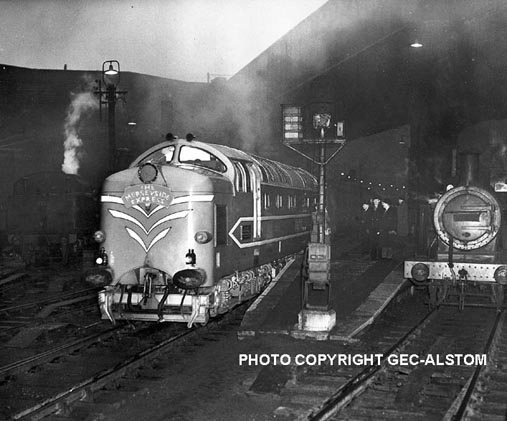
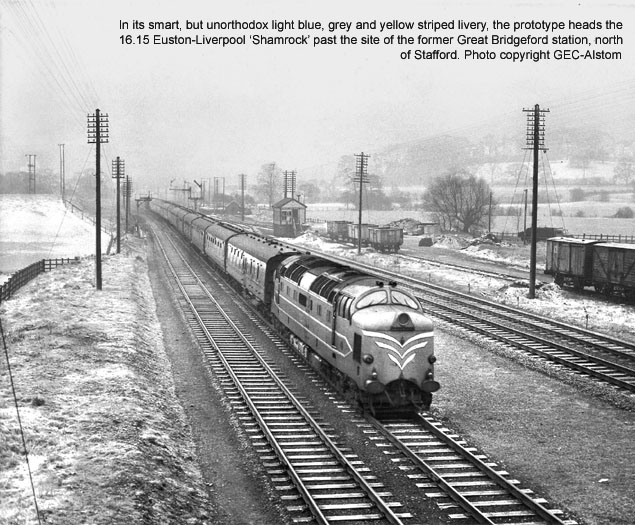
(Above-Below) As the LMR was proposing electrification of the West Coast Main Line, Deltic was transferred to the East Coast Main Line based at Hornsey. The ER recognised its full potential, for having been denied ECML electrification, they urgently needed a more powerful unit to substitute its meagre EE Co Type 4 diesel fleet. The prototype awaits departure from Kings Cross with the 08.50 'White Rose' to Leeds on 7th July 1959. Photo copyright BR Eastern Region Publicity Dept. (Below) The prototype 'Deltic' heads an express passenger train at Hatfield, Hertfordshire on 10 September 1959. 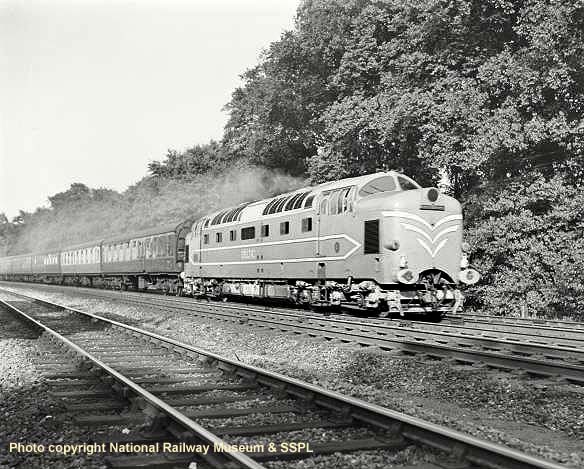

(Above-Below) These shots are among the hundreds of railway photographs now available from the NRM's archives, the photo (above) showing the prototype Deltic at speed between the tunnels at Hadley Wood tunnel on 1 October 1959 and (below) departing from Hitchin on 25 February 1959. The National Railway Museum in York has a collection of 1¾ million photos covering the history of Britain's railways from 1850 to the present day. The NRM's archives are currently being digitalised to make them available to a wider audience and preserve them for the future; click here to visit to the 'Liverpool Street Photos', or why not try the NRM's 'Doncaster Photos' page here - a visit to both is highly recommended.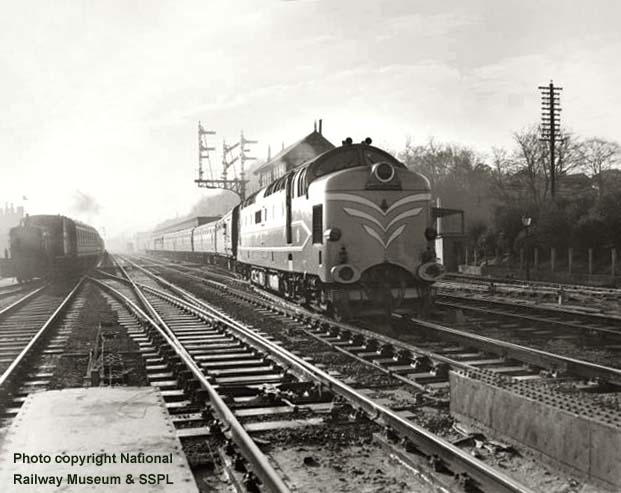
(Below) Judging by its pristine condition this looks very much like D9010's first revenue-earning role following a works visit - the up 'Elizabethan' - seen passing Selby date unknown. Introduced to traffic at Haymarket on 21st July 1961 D9010 was named The King's Own Scottish Borderer at Dumfries 8th May 1965. D9010's last train (it failed at Grantham) was the 23.00 Kings Cross-Bradford on 23rd December 1981. The loco was cut up at Doncaster in May the following year.
(Below) By April 1963, the 22 production successors (Class 55) was plying the ECML and the redundant prototype was being renovated at the EE Co Vulcan Foundry in readiness for presentation to the Science Museum in Kensington. The locomotive left the foundry on April 23rd 1963 towed by an immaculate EE Co Type 3 No D6822 (later TOPS class 37 No 37122) as far as Neasdon, where the Deltic's bogies were removed and transported separately by road to South Kensington. Here, the pair are heading south beneath the newly-erected WCML catenary. During transit 'Deltic' displayed a cover on the bodyside which read: The English Electric Co Ltd. Prototype Deltic locomotive. Presented to the Science Museum after 450,000 miles of service running. The prototype was officially handed over at a ceremony performed by Lord Nelson of Stafford on 17th May 1963. Photo copyright GEC-Alstom
(Below) Not so lucky! Had only the railway preservation movement surfaced earlier, then the prospect of one of the LMS's historical diesel locomotives being preserved would have been a certainty. Back in February 1953, the Ivatt twin Co-Cos were transferred to the SR for evaluation against the SR/Bullied ICo-Co1s at Nine Elms shed. They returned to the LMR in 1954 working Anglo-Scottish trains in multiple and singly on freight between Camden and Crewe. The pair spent long sojourns at Derby for attention caused by problems with spares for the EE Co Mk 1 engine then out of production. This severely prejudiced BR's attitude towards the pioneer diesels as ample supplies of the new EE Co Type 4 (Class 40) were making inroads on the WCML and Nos 10000/1 became surplus to requirements. Sporting an overhead electric warning sticker on its nose-end gangway doors, No 10000 is seen at Derby with SR/EE cousin No 10203 in April 1963. No 10000 was scrapped at the hands of J Cashmore of great Bridge, Staffs. No 10001 soldiered on until March 1966. Photo © D Pickup
Polite notice: All text and photographs are protected by copyright and reproduction is prohibited without the prior consent of the © owners. If you wish to discuss using the contents of this page the email address is below. Please note - this is not a 'clickable mail-to link via Outlook Express:
dheycollection@ntlworld.com


